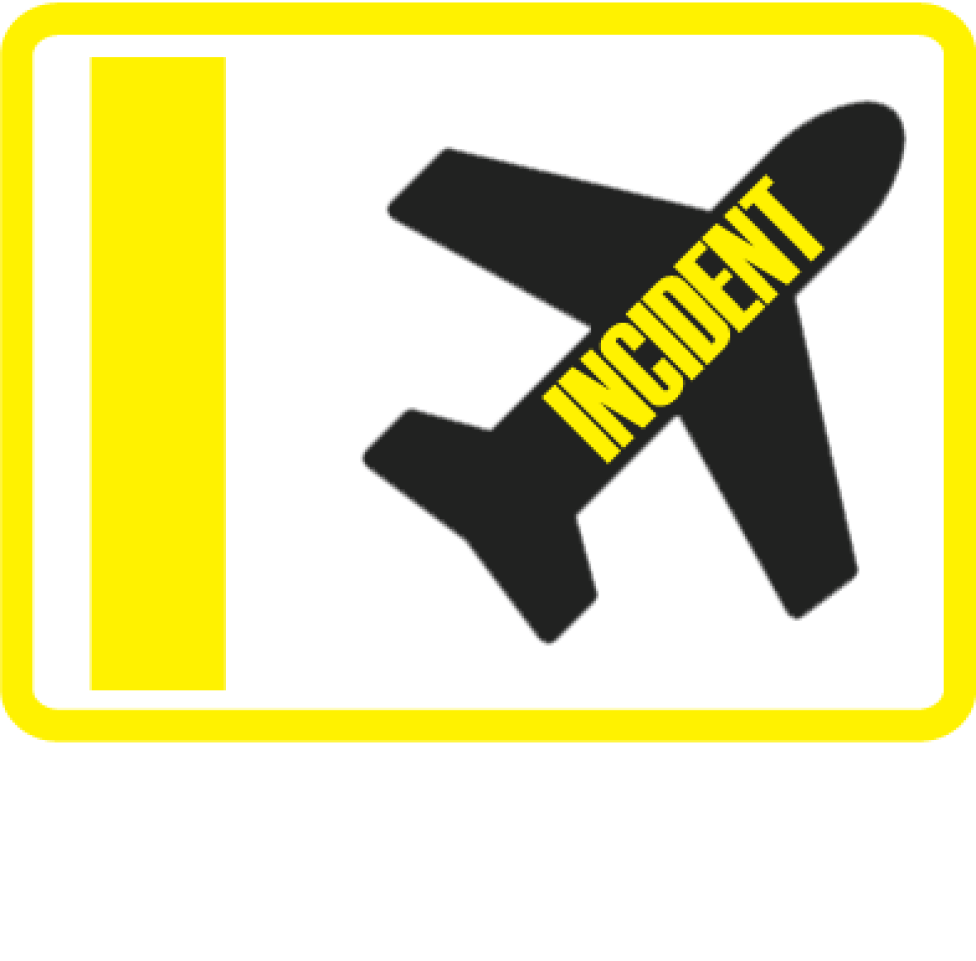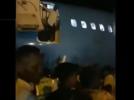Cathay Pacific A333 near Singapore on May 16th 2011, engine shut down in flight, engine fire
Singapore's Ministry of Transport (MOT) released their final report concluding the probable causes of the incident were:
- The failure of the fan blade with a 130 mm tip section missing was probably due to its mechanical strength having been compromised as a result of the use of an incorrect gas during the manufacturing process.
- Following the fan blade failure, only one of the two fuses in the engine front bearing functioned.
- The fire from the rubbing of the fan blade tips and the fan case provided the ignition source and burnt the Kevlar layers.
- The fuel pump supply line cracked due to high vibrations, resulting in fuel leak. It was likely that the heat from the burning Kevlar layers ignited the leaked fuel.
- The engine intake cowl and the fan case had shifted forward, resulting in a gap of about 30 mm between the thrust reverser units and the fan cowl door. This gap could have compromised the engine’s fire containment capability and reduced the effectiveness of the fire extinguishing agent in suppressing the fire.
- The hazardous condition of the engine fire following the fan blade failure event did not comply with the EASA CS-E 810 requirement that no hazardous condition should arise as a result of engine damage.
- After discharging both fire extinguishing bottles, the fire warning indication was flickering intermittently. The flight crew interpreted the intermittent fire warning indication light as the fire had been extinguished.
- The aircraft manufacturer’s documentation and the operator’s training did not address the condition of an intermittent flickering fire warning indication which was presented to the flight crew.
- There was no clear guideline for ATC controllers on when should a runway be reserved for an aircraft that has declared an emergency.
- The air traffic services provider did not have a dedicated radio frequency for communication between the Airport Emergency Services (AES) and the flight crew of an emergency aircraft.
- The Watch Room Officer, who was busy with his primary duties in monitoring the communication and logging events, did not have time to assist the Fire Chief (FC) and the flight crew in establishing communication. Neither did the FC ask the Watch Room Officer to assist in establishing communication with the flight crew.
The MOT reported that after the right hand engine had been shut down and the fire warning activated for a second time, the fire warning light illuminated intermittently. The flight crew interpreted that intermittent light as indication that the fire was out and informed Air Traffic Control accordingly. The flight data recorder showed however, that the fire warning remained active througout the remainder of the flight.
At Changi Airport runway 02L/20R was closed for maintenance with only runway 02C/20C remaining open for traffic. After being informed of the emergency tower initiated the re-opening of runway 02L/20R but continued to use runway 02C for departures until CX-715 was about 7nm out, only then runway 02C was reserved for the emergency traffic.
CX-715 landed on runway 02C and vacated the runway onto taxiway E-5, emergency services noticed the right hand engine was on fire and began fighting the fire. In the meantime the commander (40, ATPL, 8,534 hours total, 3,632 hours on type), pilot flying, had instructed cabin crew to remain on standby for an evacuation and attempted to establish contact with the fire chief to inquire about the status of the engine but was unable to establish contact. About 3 minutes after the first attempt to talk to the fire chief the first officer (41, ATPL, 7,385 hours total, 3,238 hours on type), pilot monitoring, opened the cockpit window and talked to the fire chief directly. The fire chief informed the first officer that the fire in the #2 engine had been put out and equipment was being arranged for the disembarkation of passengers.
The engine was found with severe internal damage, a fan blade had its tip missing, length of missing part about 130mm, all fan blades were damaged. The low pressure shaft showed evidence of contact with the intermediate pressure front shaft resulting in heavy rubbing, local deformation and a substantial bend at the rubbing location. The fan case showed substantial damage with the fan case retention panels being rubbed through by fan blade rubbing and Kevlar layers were pulled out.
The front section of the engine had shifted forward and left a gap of about 30mm between front section and thrust reverser section.
The engine pylon#s forward secondary structure showed multiple cracks.
The fuel line next to the fuel pump had a 180 degrees crack and there was evidence of fuel spraying onto a pipe.
The MOT analysed that the fracture and release of the 130mm portion of the fan blade "could be attributed to its mechanical strength having been compromised as a result of the use of an incorrect gas during the manufacturing process". This failure left the engine's rotating assembly unbalanced causing severe engine vibrations which further caused the engine pylon's secondary structure to crack and one of two fuses in the engine's front bearing to function. The MOT analysed: "The fuse system was designed and certified for the case of a full fan blade aerofoil being released. It was likely that the loss of a 130 mm tip section of the fan blade aerofoil in this event did not generate sufficient out-of-balance loads to cause the second fuse to function. Since the second fuse did not function, the LP shaft came into contact with the IP stub shaft."
The MOT concluded analysis of engine vibrations: "This occurrence showed that, while the fuse system was designed for a full fan blade aerofoil release, a partial fan blade aerofoil release could still generate substantial damages."
With respect to the engine fire the MOT analysed that the severe vibrations caused by the unbalanced rotor generated loads in the fuel line which caused cracks to form permitting fuel to be sprayed off the fuel line. The MOT analysed: "As the rotating fan blades rubbed against the inner circumference of the fan case, the heat generated was high enough to burn through the Kevlar. It was likely that the heat from the burning Kevlar ignited the fuel from the cracked fuel supply line and the burning fuel then caused further fire damage to the engine."
When the crew shut the engine down, the fuel pressure shut off valve was closed as well effectively stopping the fuel spray. However, at that time about 20-22 liters of fuel had already leaked, this amount was "sufficient to sustain a fire from the onset of the fan blade
separation until the aircraft landed (about 28 minutes later)".
Although the fire bottles were discharged the fire was not permanently extinguished. The MOT analysed: "The 30 mm gap between the thrust reverser units and the fan cowl door, which was a result of the forward shifting of the fan case, could have reduced the effectiveness of the fire extinguishing agent in suppressing the fire. It might also be that the Kevlar continued to provide an ignition source and reignited the leaking fuel after both the fire extinguishing bottles had been discharged."
The MOT analysed: "It would have been more prudent for the flight crew to assume that fire was present. While one may consider that, since the flight crew had made a decision to land the aircraft as soon as possible following the engine vibration, whether the flight crew believed correctly or wrongly the fire had been extinguished might not be material. However, if the flight crew had treated that the fire was still present and informed ATC accordingly, this might have aided ATC in planning their emergency actions, such as ceasing operations on the runway (e.g. take-off and landing) well in advance. This would have reduced the risk of the emergency aircraft having to execute a go-around should an abnormal operation (e.g. abort take-off) occurred to a departure or arrival aircraft ahead of the emergency aircraft."
The MOT voiced concern that the runway had not been kept sterile for the approaching emergency aircraft arguing: "if any of the departing aircraft had an abnormal operation that makes the runway not immediately useable (e.g. aborted take-off, aircraft parts falling off), the emergency aircraft may have to go-around and come in for another approach while the runway is being recovered. This could mean additional risk for the emergency aircraft." but continued to state that there were no specific guidelines for tower controllers.
Four safety actions were taken by the engine manufacturer, one by Europe's regulator EASA and one by Singapore's emergency services in the course of the investigation. The MOT released seven additional safety recommendations as result of the investigation.
The outboard side of the right hand engine after landing (Photo: MOT):
The missing fan blade tip (Photo: MOT):
http://avherald.com/h?article=43ca1f91/0000














Komentarze